Oil Water Separators
API Separators
API separator is a gravity separator utilizing the difference in specific gravity between two phases of liquid (removal of free oil in water) as the principle of separation.
Paramount Limited designs & constructs chain type API Oil Separator (metallic & non-metallic internals) which is the most positive free oil removal equipment equipped with a sludge removing device as well.
Paramount make “chain type API Oil Separator” is the most positive free oil removal equipment equipped with a sludge removing device as well.
API separator is a gravity separator utilizing the difference in specific gravity between two phases of liquid (removal of free oil in water) as the principle of separation.
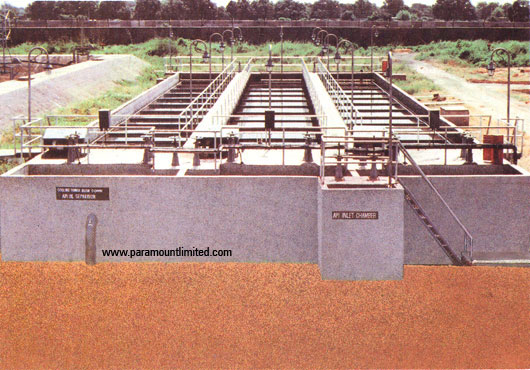
It consists of two parallel chains that are electrically driven with worm reduction gears to achieve the required driven speed. The main chains bear the FRP flights (treated teak wood flights are also available on special request) having a rectangular cross section. The drive acts as an oil skimmer during the flight movement towards the top liquid surface and as a sludge scrapper during the flight movement towards the bottom of the basin. The ergonomical design of the flights constitutes no barrier or obstruction to flow along the separator channel. A chain tensioning device made of machine screws serves as a fine adjustment for achieving the required tension on the driven chain.
The sludge removal from separator can be controlled by flat seated valves operated from the basin top platform.
Two deoiler devices (slotted pipe type) are provided in each channel for effective skimming of the oil over the liquid surface. The de-oiler devices are slotted pipe type and easy to operate and are provided with worm reduction gear to enable smooth and ease in operation through hand wheel situated at the suitable operating height from the platform.
Paramount can supply the API oil water separator with internals in both Metallic and Non-metallic parts.
Paramount has also adapted use of belt type oil skimmers at the separator discharge to make the system free of manual intervention.
Our Standard Range / Capacity / Size: 1.2 m wide x 6 m long to 6 m wide x 40 m long.
Paramount Limited supplies complete API mechanisms with critical GRP/ NYLON/ UHMWPE internal components to increase reliability in operation, protection against corrosion, lower power consumption, etc., sourced from Polychem who are a pioneer in non-metallic internals for API in the world.
The advantages of Non-metallic API internals with that of conventional types are as follows.
• Easy to install components.
• Noiseless operation.
• Insensitive to corrosion due to water characteristics.
• Insensitive to humidity in the atmosphere and hence storage of internal components does not require specific storage procedure.
• No Special painting required on components to avoid rust and corrosion.
• The light weight internals is easy to handle compared to metallic internals.
• Low energy consumption due to lower torque and driving force required for non-metallic internal components.
• Very Low maintenance as API internals is non-metallic.
• Wear due to friction in non-metallic internal is less compared to metallic internals, providing an increased operational life and Higher reliability.
• Long operation periods without major breakdown.
• Standard component internals fitting to a different size of API. No tailor made components as in Metallic API internals. Hence, spare internals is available much faster.
• Smooth finish gives a good aesthetical appeal.
• The scraper flights are specially designed for sludge collector service and constructed of fiberglass, reinforced, isophthalic polyester resin.
The standard component materials in a 100% Non-Metallic Mechanism under the supply range include the following.
• Glass reinforced polyester collector chain
• Glass reinforced Nylon Drive chain
• Cast Nylon-6 collector chain sprockets
• Nylon-6 Drive Sprocket on Stainless Steel Hub
• Bi-axially Wrapped Epoxy Fiberglass Head shaft
• UHME-PE (Ultra high molecular weight polyethylene)/ Virgin grade Bearings
• Cast Nylon-6 Stub shaft assemblies
• Fiberglass reinforced Plastic Flights and return rails
• Glass Reinforced Nylon Return rail Wall Brackets
• UHME-PE/ Virgin grade Wear strips
• Nylon 6-6 Carry and Return Shoes
• 316 Stainless Steel Mounting Hardware and Anchors
• 304 Stainless Steel Chain Guards
TPI (Tilted Plate Interceptor) Separators
Tilted / Corrugated plate Interceptors are gravity separators which utilize the difference in specific gravity between two phases of liquid (predominantly for removal of free oil in water) as the principle of separation. The high surface area for separation is provided by a lamellar arrangement of plates which also reduces the plot space requirement.
Paramount Limited designs & constructs Tilted / Corrugated plate Interceptors with technology acquired from M/s. PWT, Holland.
Tilted Plate Interceptors are gravity separators utilizing the difference in specific gravity between two phases of liquid (predominantly removal of free oil in water) as the principle of separation.
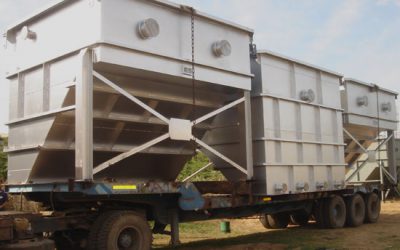
Gravity separation is a function of available surface area for separation. The Tilted plate interceptor offered by Paramount with technology acquired from M/s. PWT, Holland provides an extensive reduction in surface area requirement of a separator by introducing multi layer separation wherein area required is reduced considerably depending upon a number of such layers. It is feasible to achieve almost complete removal of all the particles which would not have normally be achieved by a single large surface separator. This is possible because of a considerable increase in the surface area of the unit, within the same depth. In most of the cases, the plates are installed at an angle of 45° or more and thus the separated material can be collected and removed by gravity.
As corrugated plate packs are predominantly used, the tilted plate pack type separators are widely known as Corrugated plate interceptor or simply as CPI separators. However, a TPI (Tilted plate interceptor) may use a corrugated type plate pack or simply plain parallel plate packs. Hence, TPI separator or Lamella separator is a generic terminology used in such type of separators.
The salient features of a TPI/ CPI separator are:
- A double slotted baffle located at the inlet of the CPI/ TPI separator evenly distributes incoming effluent water at the entrance of the plate pack separator.
- In the plate pack of the CPI/ TPI separator, the droplets of the lighter liquid are intercepted and coalesce into large droplets. They leave the pack rapidly countercurrent upwards against the liquid flow to the surface.
- Suspended solids having settling properties, if present in the aqueous phase is similarly separated in the plate pack of CPI/ TPI separator and then slides down to the sludge compartment.
- The treated clear lighter phase liquid or treated effluent (as in oil in water separators) from the CPI/ TPI separator leaves the plate pack at the bottom and gets discharged over a weir arrangement and to the outlet nozzle.
TPI/ CPIs can be supplied in modules of up to five plate pack per basin. Paramount has specialized in the design of TPI/ CPI separator installation in both RCC (Reinforced cement concrete) and steel basins. The selection of the basin of the TPI/ CPI separator is advised to the client based on the basic requirement, adaptability, time and economy criteria envisaged in the treatment process installed.
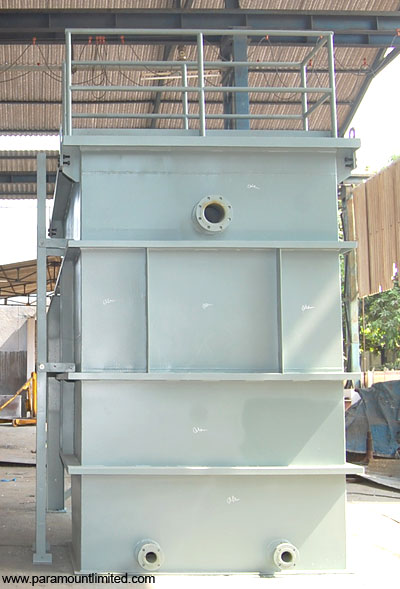
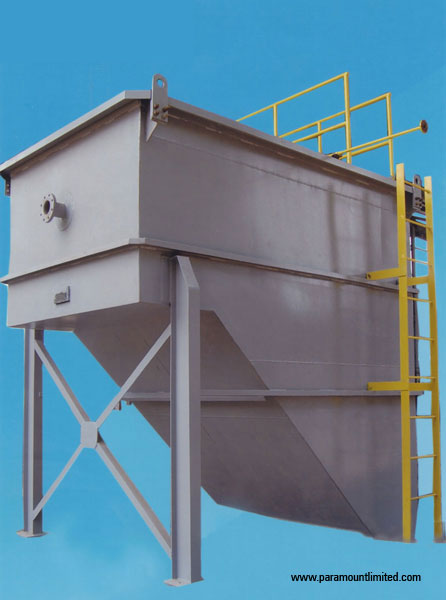
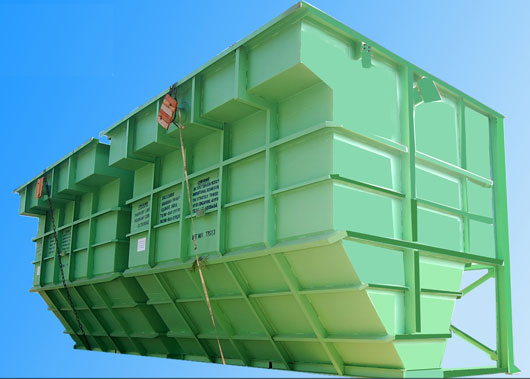
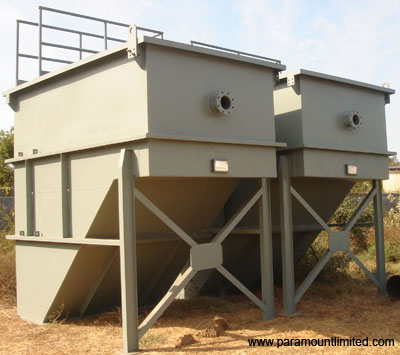
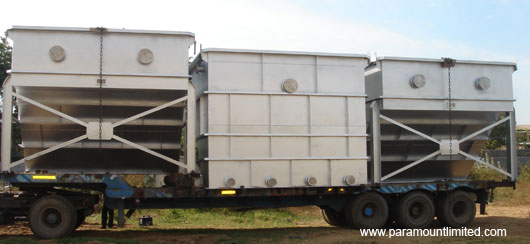
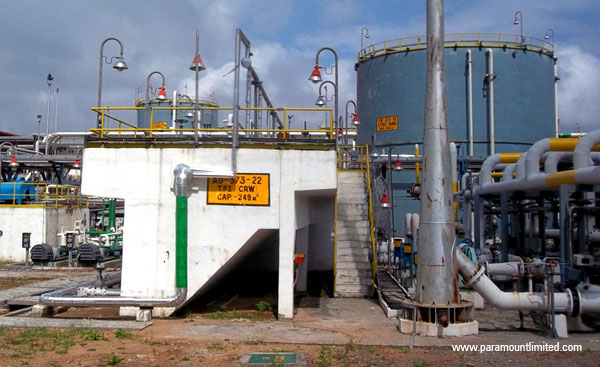
CPI (Corrugated Plate Interceptor) Separators
Tilted / Corrugated plate Interceptors are gravity separators which utilize the difference in specific gravity between two phases of liquid (predominantly for removal of free oil in water) as the principle of separation. The high surface area for separation is provided by a lamellar arrangement of plates which also reduces the plot space requirement.
Paramount Limited designs & constructs Tilted / Corrugated plate Interceptors with technology acquired from M/s. PWT, Holland.
Tilted plate Interceptors are gravity separators utilizing the difference in specific gravity between two phases of liquid (predominantly removal of free oil in water) as the principle of separation.
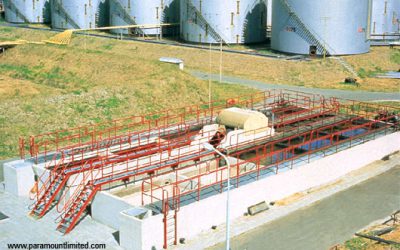
Gravity separation is a function of available surface area for separation. The Tilted plate interceptor offered by Paramount with technology acquired from M/s. PWT, Holland provides an extensive reduction in surface area requirement of a separator by introducing multi layer separation wherein area required is reduced considerably depending upon a number of such layers. It is feasible to achieve almost complete removal of all the particles which would not have normally be achieved by a single large surface separator. This is possible because of a considerable increase in the surface area of the unit, within the same depth. In most of the cases, the plates are installed at an angle of 45° or more and thus the separated material can be collected and removed by gravity.
As corrugated plate packs are predominantly used, the tilted plate pack type separators are widely known as Corrugated plate interceptor or simply as CPI separators. However, a TPI (Tilted plate interceptor) may use a corrugated type plate pack or simply plain parallel plate packs. Hence, TPI separator or Lamella separator is a generic terminology used in such type of separators.
The salient features of a TPI/ CPI separator are:
- A double slotted baffle located at the inlet of the CPI/ TPI separator evenly distributes incoming effluent water at the entrance of the plate pack separator.
- In the plate pack of the CPI/ TPI separator, the droplets of the lighter liquid are intercepted and coalesce into large droplets. They leave the pack rapidly countercurrent upwards against the liquid flow to the surface.
- Suspended solids having settling properties, if present in the aqueous phase is similarly separated in the plate pack of CPI/ TPI separator and then slides down to the sludge compartment.
- The treated clear lighter phase liquid or treated effluent (as in oil in water separators) from the CPI/ TPI separator leaves the plate pack at the bottom and gets discharged over a weir arrangement and to the outlet nozzle.
TPI/ CPIs can be supplied in modules of up to five plate pack per basin. Paramount has specialized in the design of TPI/ CPI separator installation in both RCC (Reinforced cement concrete) and steel basins. The selection of the basin of the TPI/ CPI separator is advised to the client based on the basic requirement, adaptability, time and economy criteria envisaged in the treatment process installed.
TPF (Tilted Plate Flotator)
Tilted / Corrugated Plate Flotator units are widely used for removal of emulsified oil, suspended solids etc., present in wastewater.
Paramount Limited designs & constructs Lamella Type DAF units which are also called as Tilted / Corrugated plate flotator (TPF/CPF). The TPF/CPF offered by Paramount Limited is with the technology absorbed from M/s PWT, Netherland.
Paramount offered lamella type DAF units are called Tilted plate flotator (TPF). The TPF offered by Paramount Limited is the technology absorbed from M/s PWT, Netherland.
Tilted Plate Flotator units are widely used for removal of emulsified oil, suspended solids etc., present in wastewater.
As corrugated plate packs are predominantly used, the tilted plate pack type flotators are also known as Corrugated plate flotators or simply as CPF separators. However, a TPF (Tilted plate flotator) may use a corrugated type plate pack or simply plain parallel plate packs. Hence, TPF or Lamella clarifier is a generic terminology used in such type of separators.
Effluent should be properly flocculated before it is fed to Tilted Plate Flotator. For this purpose more often a Pipe Flocculator is included prior to the TPF/ CPF unit. Coagulant (Alum) and flocculant (polyelectrolyte) solution are dosed for floc formation before the effluent feed to the TPF unit.
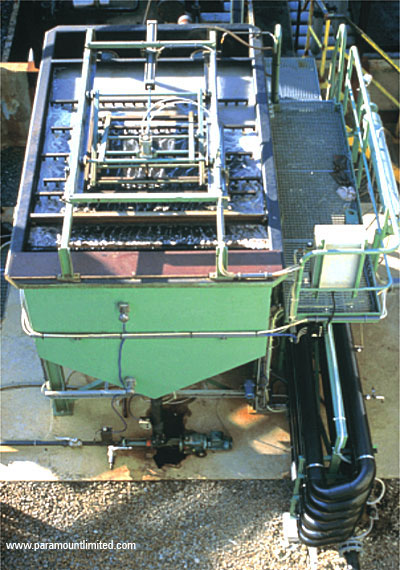
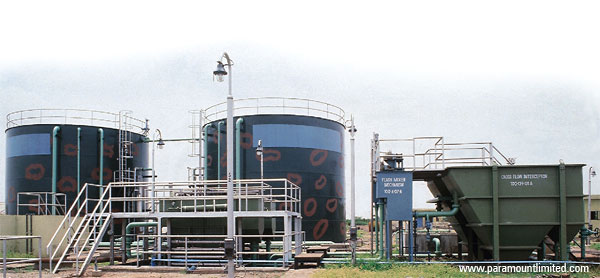
The flocculated effluent flow receives air-saturated water (re-circulating treated water) originating from the outlet side of the Tilted/ Corrugated Plate Flotator.
The recycle stream has air dissolved in it. The pressure is then released, resulting in the generation of minute diameter (micro) bubbles. These micro-sized air bubbles attach themselves to the flocs formed in the flocculates so that rising conglomerates build up.
The recirculation system consists of suction & discharge piping for recirculation pump, recirculation pump and deaerator (saturation vessel) or air water mix pump.
The conglomerates are subsequently separated in the Tilted/ Corrugated Plate Flotator system. Here, flocs are separated in the corrugated plate pack which is installed at an inclination to create a maximum surface area for separation in a minimum volume. Flow through these plate packs is maintained as laminar thus creating ideal separation condition. The separated conglomerates collect in the corrugated plate crests and subsequently flow upwards in the pack in counter-current, eventually forming a compact floating layer on the liquid surface.
The floating layer of the Tilted/ Corrugated Plate Flotator units is continuously compacted and skimmed by a patented scrapper. The treated water leaves the plate pack at the bottom end, rises and is then discharged over an adjustable weir. Accumulated solids, having settled are periodically removed by a hand operated butterfly valve.
A screw augur mechanism is installed at the bottom of the larger TPF/ CPF units in the longitudinal sludge pocket. The screw augur helps in periodic de-sludging operations.
TPF/ CPFs can be supplied in modules of up to six plate pack per basin in steel structural basin. Larger units can also be adapted in RCC structures.
CPF (Corrugated Plate Flotator)
Tilted / Corrugated Plate Flotator units are widely used for removal of emulsified oil, suspended solids etc., present in wastewater.
Paramount Limited designs & constructs Lamella Type DAF units which are also called as Tilted / Corrugated plate flotator (TPF/CPF). The TPF/CPF offered by Paramount Limited is with the technology absorbed from M/s PWT, Netherland.
Paramount offered lamella type DAF units are called Tilted plate flotator (TPF). The TPF offered by Paramount Limited is the technology absorbed from M/s PWT, Netherland.
Corrugated Plate Flotator units are widely used for removal of emulsified oil, suspended solids etc., present in wastewater.
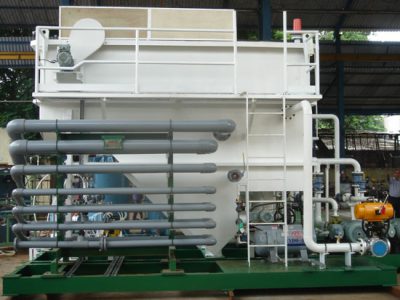
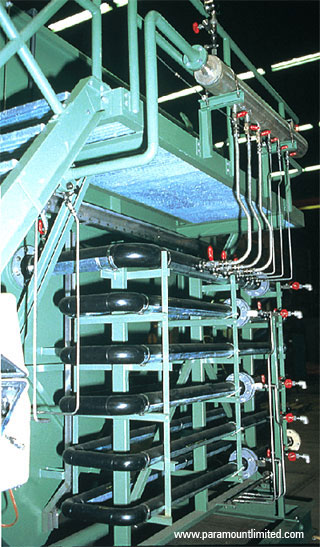
As corrugated plate packs are predominantly used, the tilted plate pack type flotators are also known as Corrugated plate flotators or simply as CPF separators. However, a TPF (Tilted plate flotator) may use a corrugated type plate pack or simply plain parallel plate packs. Hence, TPF or Lamella clarifier is a generic terminology used in such type of separators.
Effluent should be properly flocculated before it is fed to Tilted Plate Flotator. For this purpose more often a Pipe Flocculator is included prior to the TPF/ CPF unit. Coagulant (Alum) and flocculant (polyelectrolyte) solution are dosed for floc formation before an effluent feed to the TPF unit.
The flocculated effluent flow receives air-saturated water (re-circulating treated water) originating from the outlet side of the Tilted/ Corrugated Plate Flotator.
The recycle stream has air dissolved in it. The pressure is then released, resulting in the generation of minute diameter (micro) bubbles. These micro-sized air bubbles attach themselves to the flocs formed in the flocculates so that rising conglomerates build up.
The recirculation system consists of suction & discharge piping for recirculation pump, recirculation pump and deaerator (saturation vessel) or air water mix pump.
The conglomerates are subsequently separated in the Tilted/ Corrugated Plate Flotator system. Here, flocs are separated in the corrugated plate pack which is installed at an inclination to create a maximum surface area for separation in a minimum volume. Flow through these plate packs is maintained as laminar thus creating ideal separation condition. The separated conglomerates collect in the corrugated plate crests and subsequently flow upwards in the pack in counter-current, eventually forming a compact floating layer on the liquid surface.
The floating layer of the Tilted/ Corrugated Plate Flotator units is continuously compacted and skimmed by a patented scrapper. The treated water leaves the plate pack at the bottom end, rises and is then discharged over an adjustable weir. Accumulated solids, having settled are periodically removed by a hand operated butterfly valve.
A screw augur mechanism is installed at the bottom of the larger TPF/ CPF units in the longitudinal sludge pocket. The screw augur helps in periodic de-sludging operations.
TPF/ CPFs can be supplied in modules of up to six plate pack per basin in steel structural basin. Larger units can also be adapted in RCC structures.
DAF (Dissolved Air Flotation) Unit
Dissolved Air Flotation Unit (DAF) is a mechanical device which facilitates the separation of solids and emulsified oil from the denser liquid phase by use of air saturated water to generate floatation bubbles.
PParamount Limited designs & constructs Dissolved air flotation (DAF) units to treat emulsified oil, free oil having finer oil globule sizes (sizes less than 45microns which normally cannot be removed by gravity separators in an economical manner) and suspended particles in the effluent.
Paramount offers Dissolved air flotation (DAF) units to treat emulsified oil, free oil having finer oil globule sizes (sizes less than 45microns which normally cannot be removed by gravity separators in an economical manner) and suspended particles in the effluent.
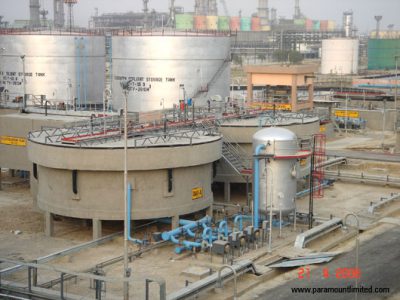
DAF separation principle is based on the fact that air soluble in the liquid is in direct proportion to the pressure applied. A part of the treated effluent is recycled to the saturation vessel by means of high pressure recycle pump. Two methodologies are used for air injection – air injection in the recycle pumps and the most widely used saturation/ pressurization vessel to ensure saturation of the liquid with air.
The saturated liquid is de-pressurized into the flotation tank through a valve located as the discharge line of recycle pump near DAF Unit. When the pressure is released the air dissolved under pressure comes out of the solution in the form of minute bubbles. These minute bubbles get attached to the flocculated effluent and thus forming surface floating scum like solids with a specific gravity less than the effluent. A skimmer is normally employed to de-skim the scum from the water surface.
Paramount offers DAF units in three models suiting the various needs of the client.
1 Circular DAF unit with a skimmer cum scrapper arrangement
2 Rectangular DAF unit with a skimmer cum scrapper arrangement
3 Lamella types DAF unit with skimmer and sludge outlet
Circular DAF
Paramount designs and manufacturers the circular DAF systems based on technology acquired from M/s. Esmil Process Systems Limited, UK.
Effluent dosed with a coagulant and/ or flocculant solution from flocculation tank is fed into coagulation tube (feed well) situated at the center of DAF unit.
Coagulation tube is a vertical cylinder suspended in the center of the tank where the flocculated effluent enters tangentially to ensure intimate mixing of the flocculated solids with the micro bubbles which are generated due to de-pressurization of recycled effluent (which is also fed tangentially).
The floating scum layer is continuously skimmed from the top water surface by a motorized skimmer moving perpendicular to the circumference of the DAF unit into the scum box for further disposal.
A bottom scrapper attached to the shaft of the motorized skimmer pushes the bottom sludge into the central sludge cone for periodic de-sludging operation.
The circular DAF basin is designed in steel and RCC structures depending on the size. Larger units (normally above 4m in diameter) are normally in RCC basins.
Our Standard Range / Capacity / Size – 30 m3/hr to 1000 m3/hr flow.
Rectangular DAF
A rectangular construction is predominantly selected in plots having a space constraint and are normally in RCC constructions and is an adaptation of the Circular DAF.
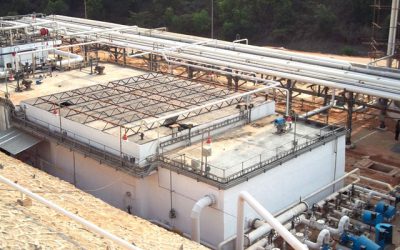
The operation of the unit is similar to the circular DAF unit. The main variation being that the skimmer cum scrapper mechanism has a reciprocating motion along the length of the unit with the scum and sludge accumulated towards the inlet of the DAF unit. A baffle constructed at the inlet positively isolates the skimmed scum from being dispersed with the influent.
A screw augur mechanism is installed at the bottom of the DAF unit in the longitudinal sludge pocket. The screw augur helps in periodic de-sludging operations.
Our Standard Range / Capacity / Size – 30 m3/hr to 1000 m3/hr flow.
Lamella types DAF unit
Paramount offered lamella type DAF units are called Tilted plate flotator (TPF). The TPF offered by Paramount Limited is the technology absorbed from M/s PWT, Netherland.
Tilted Plate Flotator units are widely used for removal of emulsified oil, suspended solids etc., present in wastewater.
Effluent should be properly flocculated before it is fed to Tilted Plate Flotator. For this purpose more often a Pipe Flocculator is included prior to the TPF unit. Alum and polyelectrolyte solution are dosed for floc formation before an effluent feed to the TPF unit.
The flocculated effluent flow receives air-saturated water (recirculating treated water) originating from the outlet side of the Tilted Plate Flotator.
The recycle stream has air dissolved in it. The pressure is then released, resulting in the generation of minute diameter (micro) bubbles. These micro-sized air bubbles attach themselves to the flocs formed in the flocculates so that rising conglomerates build up.
The recirculation system consists of suction & discharge piping for recirculation pump, recirculation pump and deaerator (saturation vessel).
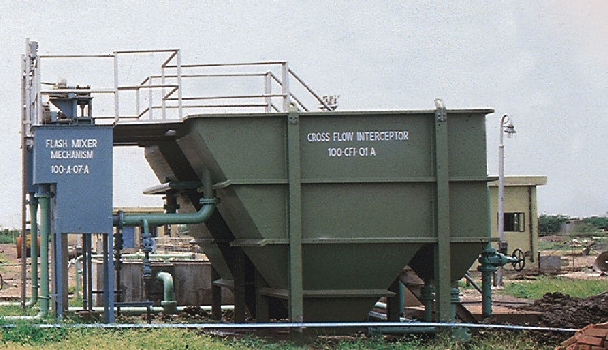
The conglomerates are subsequently separated in the Tilted Plate Flotator system. Here, flocs are separated in the corrugated plate pack which is installed at an inclination to create a maximum surface area for separation in a minimum volume. Flow through these plate packs is maintained as laminar thus creating ideal separation condition. The separated conglomerates collect in the corrugated plate crests and subsequently flow upwards in the pack in counter-current, eventually forming a compact floating layer on the liquid surface.
The floating layer of the Tilted Plate Flotator units is continuously compacted and skimmed by a patented scrapper. The treated water leaves the plate pack at the bottom end, rises and is then discharged over an adjustable weir. Accumulated solids, having settled are periodically removed by a hand operated butterfly valve.
A screw augur mechanism is installed at the bottom of the larger TPF units in the longitudinal sludge pocket. The screw augur helps in periodic de-sludging operations.
TPFs can be supplied in modules of up to six plate pack per basin in steel structural basin. Larger units can also be adapted in RCC structures.
Our Standard Range / Capacity / Size – 5 m3/hr to 100 m3/hr flow.
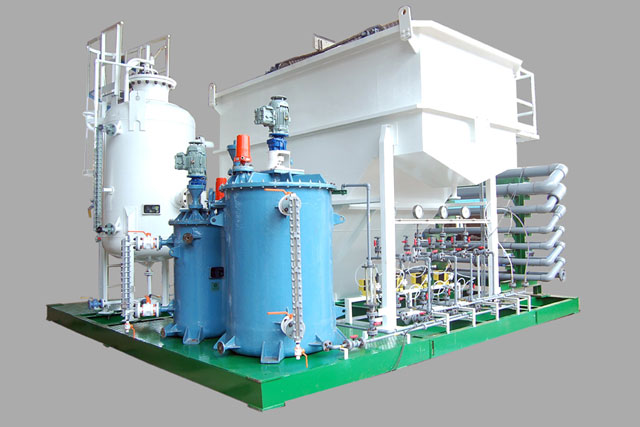
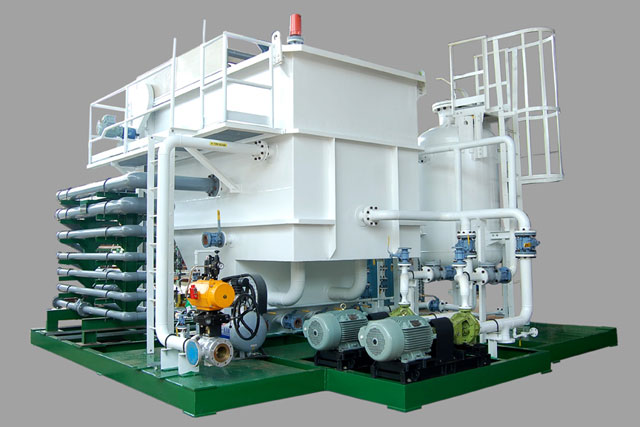
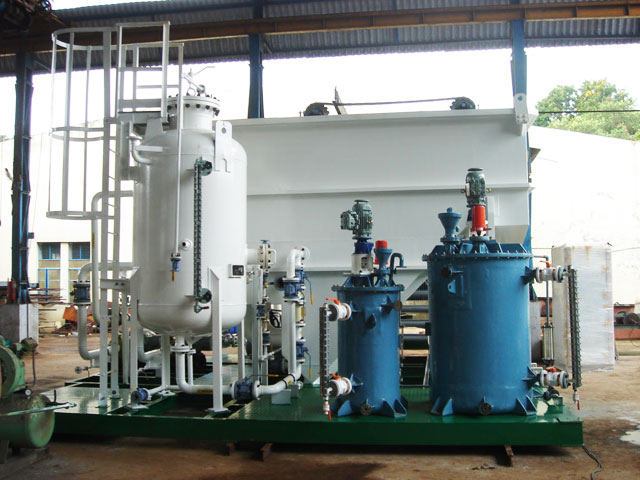
Membrane based Oil Water Separators
Discharge and re-injection of produced water are becoming challenging for the oil producers, as the discharge norms are now become very stringent.
Silicon Carbide ultra filtration membranes can very easily produce permeates with well under 5 mg/l oil with higher water flux. Oil removal typically goes down below 1 mg/l depending on oil type.
The high water flux leads to high filtration capacities per membrane element.
Silicon Carbide membranes are thermally resistant up to 800 deg. C
Silicon Carbide membranes are chemically resistant to the pH range, pH 0-14
These membranes can handle high oil concentration and fluctuations in the feed and can also remove both free oil and emulsified oil in one step.
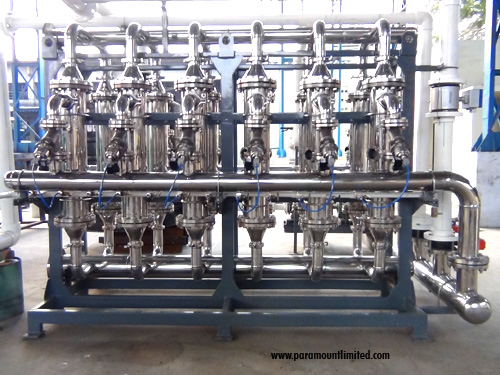
System Description
The system is a cross flow filtration system, where the feed stream is introduced under pressure by the feed pump and flows through the channels of the membrane. The feed fluid is separated into two product streams, permeate, and concentrate.
The permeate passing through the membrane flows into the porous structure of the element while particles and oil are retained on the channel surface.
Circulation pump provided to generate the cross flow inside the channels of membrane element. The feed and cross flow are tangential to the surface of the membrane.
Contact Us At
Address
Paramount Limited, Paramount Complex, Near Natubhai Circle, Race Course, Vadodara, Gujarat - 390007
Phone Number
Vadodara: +91-0265-2397111
+91-0265-6603700
New Delhi: +91-11-26186525, 26186369
Mumbai: +91-22-24078105
Email Address
Vadodara: sales@paramountlimited.com
New Delhi: delhi@paramountlimited.com
Mumbai: mumbai@paramountlimited.com

